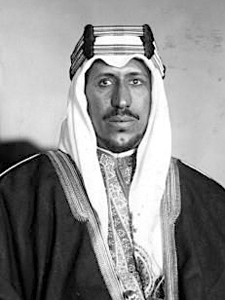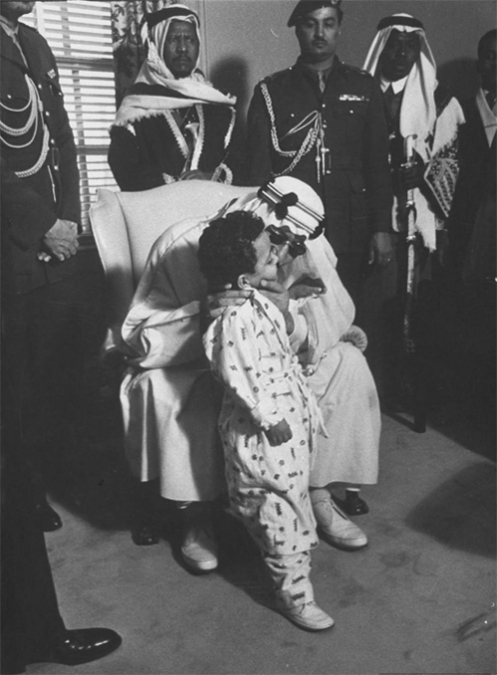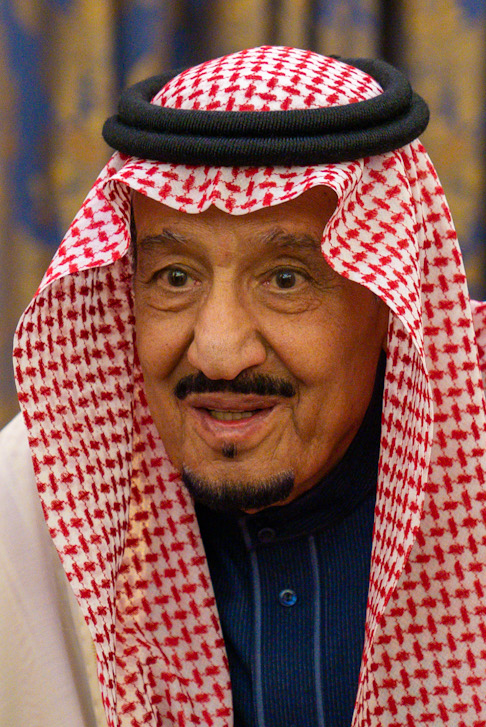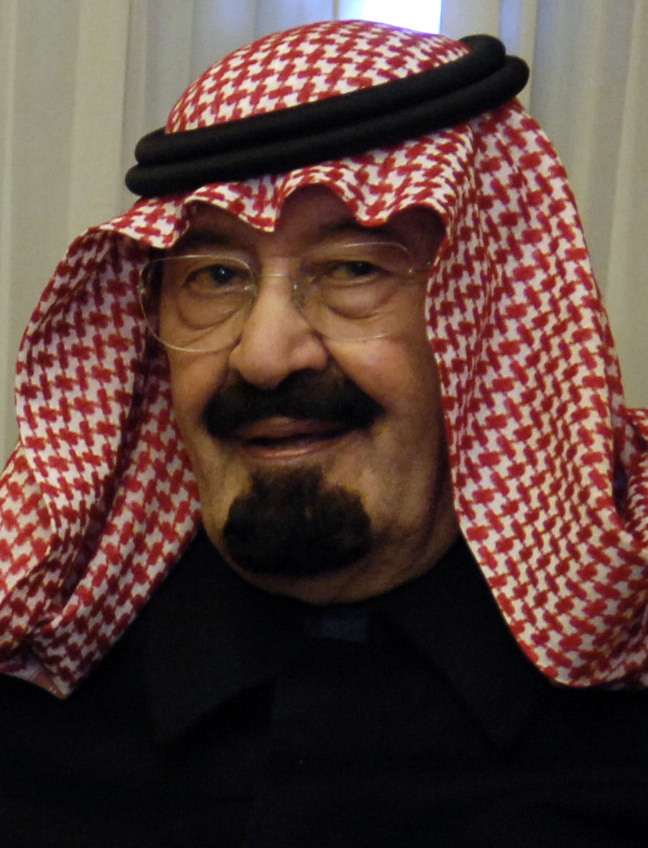by Susan Flantzer © Unofficial Royalty 2020

King Fahd of Saudi Arabia; Credit – Wikipedia
Arabic Naming Conventions
- Al – family/clan of…
- bin or ibn – son of…
- bint – daughter of…
King Fahd of Saudi Arabia was born on March 21, 1921, in Riyadh, Sultanate of Nejd, now in the Kingdom of Saudi Arabia. Fahd was one of the twelve children of King Abdulaziz, the first King of Saudi Arabia, and Hassa bint Ahmed Al Sudairi (1900 – 1969), one of his many wives. Like Sarah Al Sudairi, the mother of King Abdulaziz, Hassa was a member of the influential Al Sudairi family. Abdulaziz married her twice. They first married in 1913, divorced after a few years, and then remarried in 1920. In the period between their first and second marriages, Hassa married Abdulaziz’s younger half-brother Muhammad bin Abdul Rahman, and had one son from this marriage. Abdulaziz remained in love with Hassa and forced his half-brother to divorce her so that he could remarry her.

Fahd and Salman, the two members of the Sudairi Seven who became kings; Credit – By Qrmoo3 – Own work, CC BY-SA 4.0, https://commons.wikimedia.org/w/index.php?curid=66343065
Hassa bint Ahmed Al Sudairi and King Abdulaziz had seven sons and five daughters. No other wife of King Abdulaziz produced more sons than Hassa. In Arab culture, the most prominent wife is the one who gives birth to the largest number of sons and so Hassa became Abdulaziz’s most valued wife. Their sons are known as the Sudairi Seven. The oldest son Fahd was King of Saudi Arabia from 1982 to 2005, the second and fourth oldest sons Sultan and Nayef both served as Crown Prince but predeceased their half-brother King Abdullah, and the sixth-oldest son Salman succeeded Abdullah as King of Saudi Arabia in 2015. The Sudairi Seven were the largest bloc of full brothers among Abdulaziz’s sons and wielded a substantial amount of coordinated influence and power.
King Fahd had eleven younger full siblings:
- Prince Sultan bin Abdulaziz Al Saud (1928 – 2011)
- Prince Abdul Rahman bin Abdulaziz Al Saud (1931 – 2017)
- Prince Nayef bin Abdulaziz Al Saud (1934 – 2012)
- Prince Turki bin Abdulaziz Al Saud (1934 – 2016)
- King Salman (born 1935), the current King of Saudi Arabia
- Prince Ahmed bin Abdulaziz Al Saud (born 1942)
- Princess Luluwah bint Abdulaziz Al Saud (1928 – 2008)
- Princess Latifa bint Abdulaziz Al Saud (deceased)
- Princess Al Jawhara bint Abdulaziz Al Saud (died 2019)
- Princess Jawahir bint Abdulaziz Al Saud (died 2015)
Embed from Getty Images
Five sons of King Abdulaziz board a plane at Herne Airport in Hampshire, England on August 31, 1945: Left to Right: Saudi Ambassador to the United Kingdom, Nawaf, Abdullah, Fahd, Mohammed, Faisal
Abdulaziz had a polygamous household comprising several wives at a time and numerous concubines. It is thought he had a total of 22-24 wives. Abdulaziz was the father of almost a hundred children, including 45 sons of whom 36 survived to adulthood. Fahd had many half-siblings, too numerous to list here. See Wikipedia: Descendants of Ibn Saud (Abdulaziz). The six Kings of Saudi Arabia who followed King Abdulaziz were all his sons. Four of them were the half-brothers of Fahd, and one, Salman, was Fahd’s full-brother. King Fahd succeeded his half-brother King Khalid and was succeeded by his half-brother King Abdullah.
- King Saud of Saudi Arabia (1902 – 1969, reigned 1953 – 1964, deposed)
- King Faisal of Saudi Arabia (1906 – 1975, reigned 1964 – 1975, assassinated)
- King Khalid of Saudi Arabia (1913 – 1982, reigned 1975 – 1982)
- King Abdullah of Saudi Arabia (1924 – 2015, reigned 2005 – 2015)
- King Salman of Saudi Arabia (born 1935, reigned 2015 – present)
Fahd and his siblings were much younger than the previous Kings of Saudi Arabia and Abdulaziz’s other older children. By 1926, Abdulaziz had reached his goal of consolidating the Arabian peninsula and was then King of the dual Kingdoms of Hejaz and Nejd. In 1932, the two kingdoms of the Hejaz and Nejd were united as the Kingdom of Saudi Arabia. Therefore, during the childhood of Fahd and his siblings, the situation was more settled and stable.
Abdulaziz’s older sons were educated by tutors. However, by the time Fahd and his brothers were ready to be educated, their father had established the Princes’ School on the second floor of Deera Palace in Riyadh. Following his education at the Princes’ School, Fahd attended the Religious Knowledge Institute in Mecca where he studied Wahhabi Islam.
King Fahd was married at least thirteen times but divorced eight of his wives. He had six sons and four daughters. Only five wives had children.
Princess Al-Anoud bint Abdulaziz bin Musaed bin Jalawi Al Saud (1923 – 1999), had five sons and one daughter
- Prince Faisal bin Fahd bin Abdulaziz Al Saud (1945 – 1999)
- Prince Muhammad bin Fahd bin Abdulaziz Al Saud (born 1950)
- Prince Saud bin Fahd bin Abdulaziz Al Saud (born 1950)
- Prince Sultan bin Fahd bin Abdulaziz Al Saud (born 1951)
- Prince Khalid bin Fahd bin Abdulaziz Al Saud (born 1958)
- Princess Latifa bint Fahd bin Abdulaziz Al Saud (died 2013)
Al Jawhara bint Ibrahim Al Ibrahim, had one son, she divorced from her first husband to wed King Fahd
- Prince Abdulaziz bin Fahd bin Abdulaziz Al Saud, (born 1973)
Princess Noura bint Turki bin Abdullah bin Saud bin Faisal Al Saud (died 2018), had one daughter, divorced
- Princess Al Anoud bint Fahd bin Abdulaziz Al Saud
Princess Tarfa bint Abdul Aziz bin Fahd bin Muammar, had one daughter, divorced
- Princess Lulwa bint Fahd bin Abdulaziz Al Saud
Princess Watfa bint Ubaid bin Ali Al-Jabr Al-Rasheed, had one daughter, divorced
- Princess Al-Jawhara bint Fahd bin Abdulaziz Al Saud (died 2016)
Embed from Getty Images
Crown Prince Fahd smiles as he poses for media prior to his talks at Elysee Palace in Paris with French President Valery Giscard d’Estaing, July 21, 1975
In 1953, Fahd made his first official state visit, attending the coronation of Queen Elizabeth II of the United Kingdom on behalf of his half-brother King Saud. He was the first Minister of Education, serving from 1954 – 1962. He then served as Minister of Interior from 1962 – 1975.
On March 25, 1975, King Faisal of Saudi Arabia was shot and killed by his 30-year-old nephew Prince Faisal bin Musaid bin Abdulaziz Al Saud at the Royal Palace in Riyadh. (See Unofficial Royalty: Assassination of King Faisal of Saudi Arabia.) Faisal was succeeded by his half-brother Khalid and Fahd was immediately appointed Crown Prince of Saudi Arabia. King Khalid suffered from ill-health before and during his reign and Crown Prince Fahd was often in charge of ruling the country. Upon the death of King Khalid on June 13, 1982, Fahd became King of Saudi Arabia. His half-brother, the future King Abdullah, was appointed Crown Prince of Saudi Arabia on the same day. In 1986, King Fahd adopted the title Custodian of the Two Holy Mosques replacing His Majesty, to signify an Islamic rather than a secular authority.
Embed from Getty Images
Queen Elizabeth The Queen Mother, Prince Philip, Duke of Edinburgh, King Fahd of Saudi Arabia and Queen Elizabeth II attend a State Banquet at Buckingham Palace on March 1, 1987
In 1990, Iraqi forces under Saddam Hussein invaded Kuwait, placing the Iraqi army on the Saudi-Kuwaiti border. King Fahd agreed to host American-led coalition troops in Saudi Arabia and later allowed American troops to be based there. This decision brought him considerable criticism and opposition from many Saudis and his full-brothers, the Sudairi Seven, who objected to the presence of foreign troops on Saudi soil.
King Fahd suffered a debilitating stroke on November 29, 1995. He became noticeably frail and had to use a cane and then a wheelchair. Although he still attended meetings and received selected visitors, Crown Prince Abdullah took on much of King Fahd’s responsibilities and acted as the de facto regent of Saudi Arabia.
Embed from Getty Images
Members of the Saudi royal family pray over the body of King Fahd at the Imam Turki bin Abdullah Mosque in Riyadh, August 2, 2005
On May 27, 2005, King Fahd was admitted to the King Faisal Specialist Hospital in Riyadh, Saudi Arabia for unspecified medical tests. He died on August 1, 2005, and was succeeded by his half-brother Abdullah. King Fahd’s body was carried to the Imam Turki bin Abdullah Mosque in Riyadh for the funeral prayers. Many foreign dignitaries attended the funeral on August 2, 2005, including American Vice President Dick Cheney, French President Jacques Chirac, King Juan Carlos of Spain, Prince Charles of the United Kingdom, Sultan Hassanal Bolkiah of Brunei, Pakistan President Pervez Musharraf, King Abdullah II of Jordan, and Palestinian President Mahmoud Abbas. King Fahd’s body was then carried the short distance to the Al Oud cemetery. Only Saudi royal family members and Saudi citizens were present as the body was lowered into the grave.
Embed from Getty Images
The grave of King Fahd
This article is the intellectual property of Unofficial Royalty and is NOT TO BE COPIED, EDITED, OR POSTED IN ANY FORM ON ANOTHER WEBSITE under any circumstances. It is permissible to use a link that directs to Unofficial Royalty.
Works Cited
- Ar.wikipedia.org. 2020. أسرة فهد بن عبد العزيز آل سعود. [online] Available at: <https://ar.wikipedia.org/wiki/%D8%A3%D8%B3%D8%B1%D8%A9_%D9%81%D9%87%D8%AF_%D8%A8%D9%86_%D8%B9%D8%A8%D8%AF_%D8%A7%D9%84%D8%B9%D8%B2%D9%8A%D8%B2_%D8%A2%D9%84_%D8%B3%D8%B9%D9%88%D8%AF> [Accessed 3 September 2020].
- Ar.wikipedia.org. 2020. فهد بن عبد العزيز آل سعود. [online] Available at: <https://ar.wikipedia.org/wiki/%D9%81%D9%87%D8%AF_%D8%A8%D9%86_%D8%B9%D8%A8%D8%AF_%D8%A7%D9%84%D8%B9%D8%B2%D9%8A%D8%B2_%D8%A2%D9%84_%D8%B3%D8%B9%D9%88%D8%AF> [Accessed 3 September 2020].
- En.wikipedia.org. 2020. Fahd Of Saudi Arabia. [online] Available at: <https://en.wikipedia.org/wiki/Fahd_of_Saudi_Arabia> [Accessed 3 September 2020].
- En.wikipedia.org. 2020. Sudairi Seven. [online] Available at: <https://en.wikipedia.org/wiki/Sudairi_Seven> [Accessed 3 September 2020].
- House of Saud. 2020. Fahd Of Saudi Arabia – House Of Saud. [online] Available at: <https://houseofsaud.com/profiles/fahd-of-saudi-arabia/> [Accessed 3 September 2020].




















